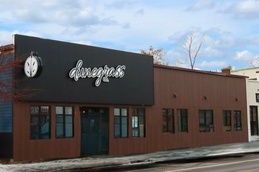A Trailblazer's Tale and the Heritage Trail
Guest Opinion
By June Thaden | Aug. 17, 2024
Traverse City’s first non-motorized trail came soon after the widening of US-31 North, which left no room for cyclists. A group formed to find a solution, with core leadership from Rick Antosh, Peter Doren, and me. We proposed a non-motorized trail from Woodmere to Acme along the old rail line.
The Michigan State Transportation Committee met in 1987, where the director promptly recommended a 7.3-mile path, creating Michigan’s first Rail with Trail. That’s where the Traverse Area Recreation Trail (TART) was born. MDOT built the trail with funding from MDOT, Rotary Charities, and Grand Traverse County. Traverse City Light & Power installed lighting. The first section, from Woodmere to Three Mile, opened in September 1990, and the section to Bunker Hill followed in October 1995.
By 1995, Friends of TART had a board, began efforts to build the Leelanau and Vasa Trails, and commissioned the now recognizable TART logo.
To celebrate this progress, we hosted Northern Trails Day on June 3, 1995, at the Open Space. I was the happy chair. Speakers included Senator Carl Levin and the National Park Service’s Thomas Ross. There was great community turnout and support, with plans on display for area trails, including the dedication of the Murchie Bridge improvement plan. The event featured clowns, a brass band, and a packed bike corral to boot.
In 1997, Friends of TART received the Environmental Excellence Award from the Federal Highway Administration, honoring our Excellence in Non-Motorized Transportation. Mike Dillenbeck and I had the privilege of accepting the award from Jane Garvey in Washington, D.C.
Growing in tandem, TART, the Vasa Pathway, and the Leelanau Trail merged into one new entity in 1998, known as TART Trails.
TART initially prioritized safe routes for transportation. We soon learned that the first paved trail in town served many other needs. I will never forget my first bike ride on the newly paved section from Woodmere to Three Mile. There was an older woman walking on the trail with a broad grin on her face. I stopped, and she explained that she could not walk on her dirt street with no sidewalks. TART allowed her to get the daily exercise she needed.
As new trails opened, it became evident that the boardwalk through wetlands near the state park was introducing people to interesting natural environments. The benefits were obviously transportation-related, but human (and pet) health and education on the importance of nature quickly followed.
As TART Trails matured, we realized the valuable trail benefits beyond just transportation, including community building and economic impact.
I believe that environmental education is another prime virtue of trails. As I’ve traveled, I’ve walked many trails of all sizes through woods and wetlands, allowing me to explore natural areas otherwise not accessible. I’ve lingered along boardwalks in Florida, Texas, and New Zealand, watching critters I’d never seen before in their natural habitats. Many of these were small footpaths. Others were more developed, allowing people with disabilities access in wheelchairs and bicycles, often within National Parks.
M-22 is a highway often with narrow paved shoulders and poor sight distances that traverses a beautiful area that many want to see. The Sleeping Bear Dunes National Lakeshore wanted a safer, more enjoyable route for bicyclists and walkers. The Sleeping Bear Heritage Trail was their solution, and now 21 miles are completed. The northern four miles will provide safe, non-motorized travel from one end of Sleeping Bear to the other.
Some people are opposed to this remaining section, but others, like me, believe the loss of trees (especially those slender young ones) is acceptable. The boardwalk through a short section of wetlands will allow for the appreciation of wetlands with minimal impact.
Our Lake Michigan shores and forests face numerous challenges, including a disease killing the beautiful, large beech trees. When one of these great trees falls, it takes younger, strong trees with it. The trail can help manage this forest ecosystem and will provide environmental education to the many curious walkers and bicyclists wanting to learn more about this region.
Those of us who have hiked many of the great footpaths in Sleeping Bear know the dunes, trees, and plants that buttress the big lakes. But many need the security of a more accessible trail, such as this last section of the Heritage Trail.
June Thaden was one of the three founding board members of The Friends of TART and a charter member, as well as one of the first presidents of the Cherry Capital Cycling Club. She also played a key role in founding the Michigan Chapter of the Rails to Trails Conservancy and served as President of the League of Michigan Bicyclists. On the national stage, June served on the board and as president of the League of American Bicyclists. Currently, she contributes her expertise as secretary and archivist for the Northern Michigan Environmental Action Council (NMEAC).
Trending

Michigan’s Marijuana Tax at Work
Cannabis has become a big business in northern Michigan, and local governments are putting tax dollars earned from dispensar… Read More >>
California Sober: Why People Are Switching from Alcohol to Weed
They call it “California sober.” Generally speaking, this term applies to folks who use marijuana but abstain f… Read More >>
The Legacy of Student Activism
“It’s a physical letter to your representative,” Alex Tank says when asked to define the word “prote… Read More >>


